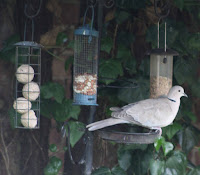Greylag Geese
I saw this beautiful little greylag goose family while I was
out with the official blog dog last week.
I was delighted to see them as usually in my local patch I only see
Canada Geese and their goslings.
Although it looks like I’m close by them, I got the photo from a
distance on top of a bank and left as soon as I’d taken the picture so as not
to disturb them.
Greylag geese, or to give them their catchy Latin name Anser
Anser, are found in gravel pits, lakes and reservoirs year round in southern
Britain. There is a wild breeding
population further North, our southern birds are thought to be the result of
reintroductions in the 60’s and 70’s. They eat grass, cereals leaves, spilled
grain and green shoots. As grass is low
in nutritional value they graze almost constantly. Interestingly, the grass doesn’t remain in
the gut for long, as the bird needs to be unhindered for flight. This explains why there’s goose poo
everywhere when there are geese present!
Greylags mate for life.
They make a neat nest on the ground among dense reeds, rushes or willow
thickets or a floating raft of vegetation.
The female lays 3 to 5 eggs, and while she incubates them for 28 days
the male guards them. Once the goslings
hatch both adults protect them and rear them.
The young leave the nest soon after they hatch and are fully fledged at
8 or 9 weeks. They will stay as a little
family unit and migrate in a large flock.
They will separate once they return to the breeding grounds the
following year.
Greylag geese are easily distinguished by their plumage. They have a pretty pinkish orange bill, with
buff brown head and neck and darker feathers across the wings. In flight, they display a distinctive white
rump. They are an understated but pretty
goose.
Hopefully this little family will have a successful summer
and will migrate safely. Who knows,
perhaps they’ll return next year and raise another family!



Comments
Post a Comment